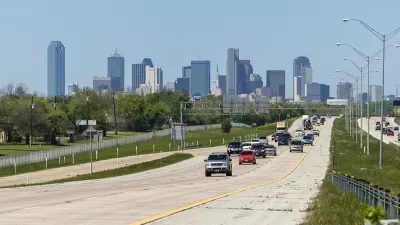Despite its insistence that the technology would only target criminals, Dallas Area Rapid Transit (DART) should reconsider using facial recognition software to address crime. The potential for abuse may be too high.

Prompted by concerns about crime, Dallas' DART system is experimenting with facial recognition software linked to an offender database. Although officials likely have good intentions, Michael A. Lindenberger is worried about the creep factor: will riders be logged and tracked every time they use the system?
The question is whether DART will restrict its use of the technology to criminal situations alone. "DART says it will build its own database of names and photos, based on incidents in which DART riders come to the attention to DART police. Maybe you get busted for not paying your fare. The police take your picture, and in you go to the database. You get in a fight on the train, and in you go."
While Lindenberger's concerns may be unfounded right now, facial recognition could become yet another way to assault citizens' privacy and anonymity. "Computers at DART could be building a database full of information about each of its riders, forevermore. And someday, if DART wants to find me at 8:30 on a Monday morning, it won't even have to ask its cameras to help. It will have years' worth of my travel habits, and will simply make a guess. It'll be a pretty good one."
FULL STORY: DART should scrap its creepy plan to use facial recognition software

Alabama: Trump Terminates Settlements for Black Communities Harmed By Raw Sewage
Trump deemed the landmark civil rights agreement “illegal DEI and environmental justice policy.”

Planetizen Federal Action Tracker
A weekly monitor of how Trump’s orders and actions are impacting planners and planning in America.

Why Should We Subsidize Public Transportation?
Many public transit agencies face financial stress due to rising costs, declining fare revenue, and declining subsidies. Transit advocates must provide a strong business case for increasing public transit funding.

Judge Orders Release of Frozen IRA, IIJA Funding
The decision is a victory for environmental groups who charged that freezing funds for critical infrastructure and disaster response programs caused “real and irreparable harm” to communities.

‘Clybourne Park’ Sets Stage for Housing Equity Discussions
Clybourne Park, a play exploring race, real estate, and community tensions, can set the stage for discussion on the lasting impacts of housing discrimination, gentrification, and the fight for affordability.

Understanding Road Diets
An explainer from Momentum highlights the advantages of reducing vehicle lanes in favor of more bike, transit, and pedestrian infrastructure.
Urban Design for Planners 1: Software Tools
This six-course series explores essential urban design concepts using open source software and equips planners with the tools they need to participate fully in the urban design process.
Planning for Universal Design
Learn the tools for implementing Universal Design in planning regulations.
Caltrans
Smith Gee Studio
Institute for Housing and Urban Development Studies (IHS)
City of Grandview
Harvard GSD Executive Education
Toledo-Lucas County Plan Commissions
Salt Lake City
NYU Wagner Graduate School of Public Service




























